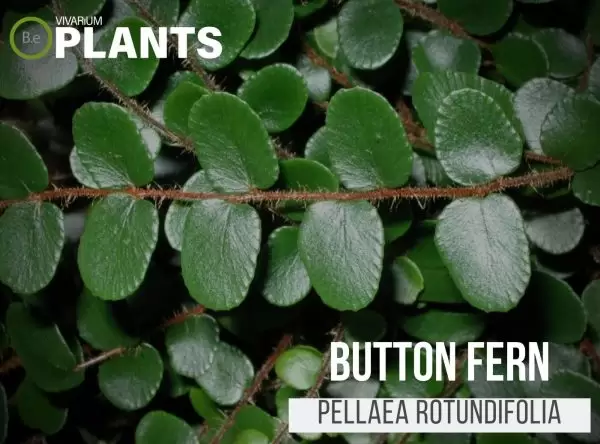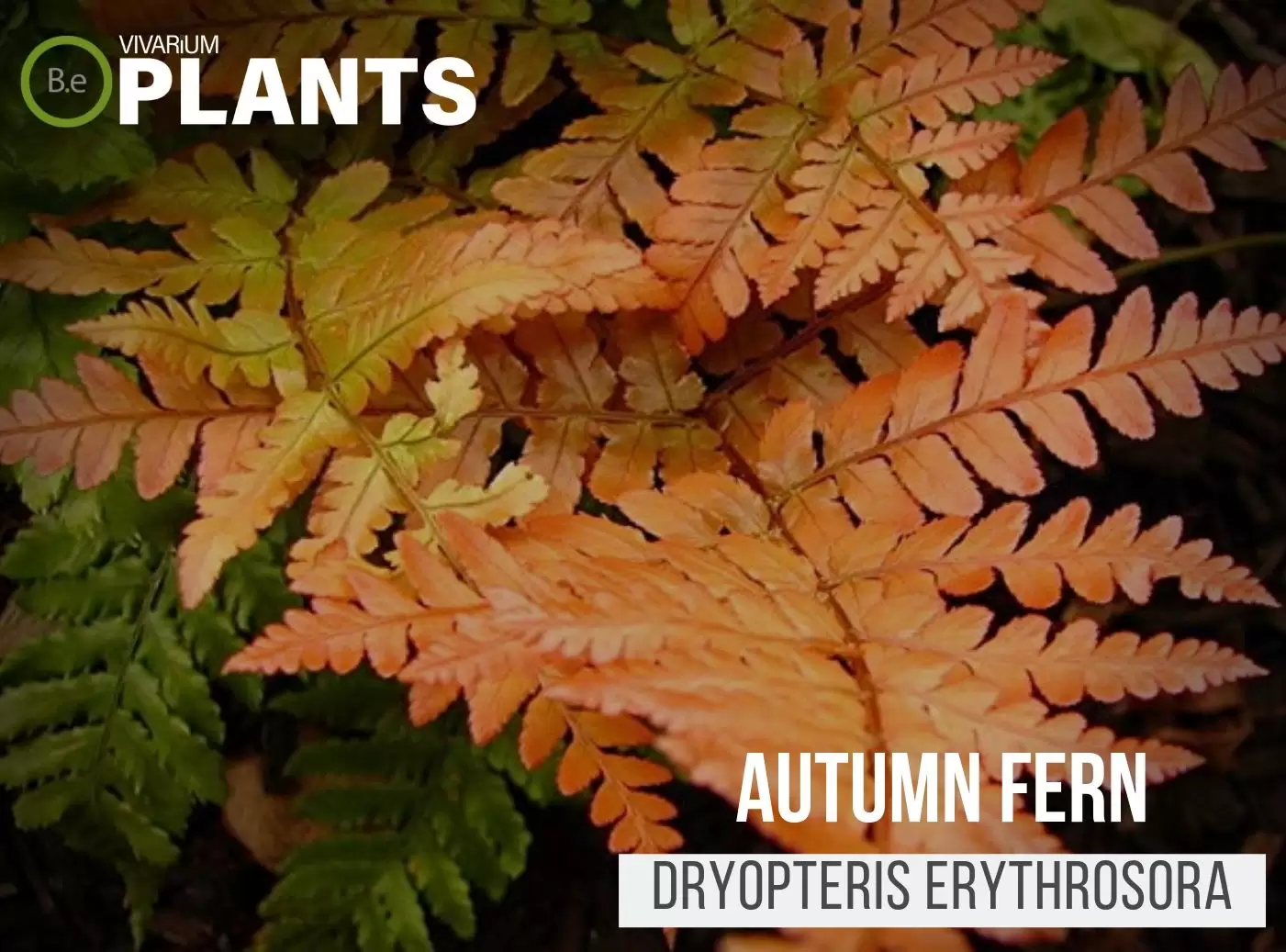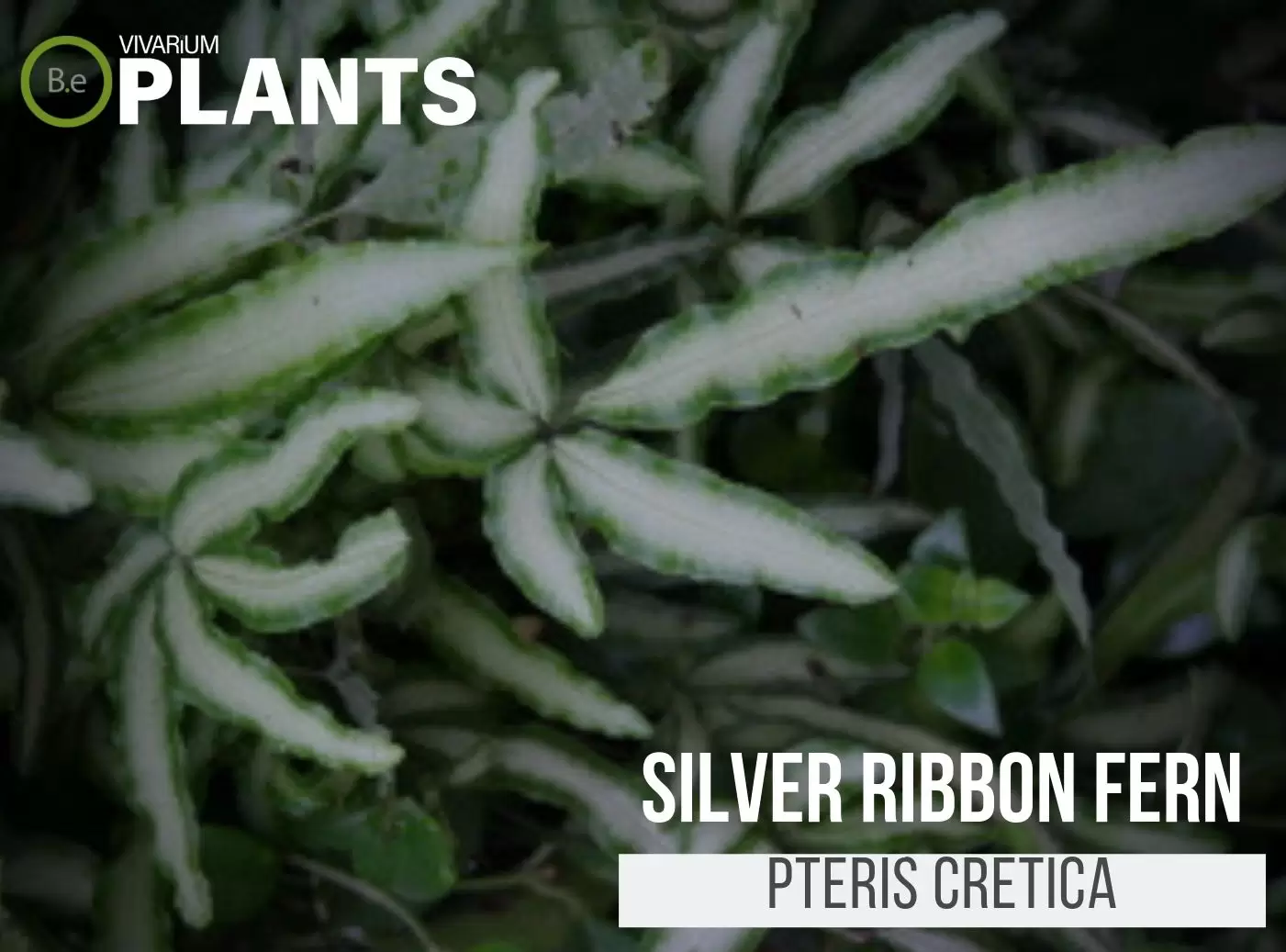It is becoming a more common practice every day to see houseplants used as vivarium plants.
Button Fern (Pellaea rotundifolia) is among one of those popular housekeeping plants beginning to make its way into the vivarium hobby.
This relatively hardy fern has some unique characteristics to it that make its caretaking requirements slightly different from other terrarium ferns.
Nonetheless, this article will take a closer look at the plant and explore important factors about this plant you should know before buying one.
| Quick Stats: | |
|---|---|
| Scientific Name | Pellaea rotundifolia |
| Common Name | Button Fern, New Zealand Cliff Brake, Round Leafed Fern |
| Family Name | Pteridaceae |
| Habitat | Forest, Woodlands |
| Temperature | 60°F to 70°F |
| Height | 6 to 12 inches Tall |
| pH | 5.0 to 6.0 |
| Lighting | Bright |
Table Of Contents:
ToggleWhat Is Button Fern?
Pellaea rotundifolia is a species of fern that botanist has grouped under the Pteridaceae family.
Commonly referred to as button fern, this plant grows in a clumpy structure with branches that creep out in a very vine-like fashion.
While closely resembling the lemon button fern, Pellaea rotundifolia exhibits a noticeably larger, darker color to its leaves.
Many proud owners living in the northeastern region of the states will usually place this plant outside of a window or on their lawn since this fern has the ability to tolerate colder climates.


Button Fern Facts
Besides Button Fern, Pellaea rotundifolia is also commonly referred to as New Zealand Cliff Brake and Round Leafed Fern due to the distinctive look of its leaf peddles as well as its indigenous habitat.
This plant is an endemic fern to New Zealand as well as Australia.
The fact that this species of fern is a plant indigenous to those islands makes it a bit challenging to find compared to more usual ferns.
Button Ferns are most known for their ability to tolerate close-to-freezing temperatures.
This ability makes it a bit more susceptible to tropical environments like the kind we would typically put a fern in when making terrariums.
Description
Button ferns display arching branches of round penny-shaped leaves.
The leaves are typically a dark green color but will brown when left without water for a period of time.
Growing to about 3/4 of an inch in circumference, the leaves pennate along the fern stem in a very uniform pattern.
The stems are a reddish-brown color and collectively sprout from a cluster of slightly bigger branches at its base.
This plant at its full adult size will grow as tall as about a foot in height before crowning over.
Habitat
Being a native plant to New Zealand, button fern is conditioned to a habitat moderately high in humidity and shaded areas.
Contrary to most ferns, this plant actually prefers dryer soil.
Button fern can be found carpeting the forest floor of a woodland-type environment.
Furthermore, it’s also very common to find this plant growing near cliffs between stones.
Temperatures range quite drastically in this location.
Going as high as 80 degrees Fahrenheit and well below freezing with temps as low as the 20s.
Even though Pellaea rotundifolia won’t quite survive freezing temperatures, it does do rather well in a colder climate compared to the more popular tropical ferns.
The ideal temperature range for this plant is between 60 and 70 degrees Fahrenheit.
PH Preference
Like many ferns of this species, button fern tends to prefer to be on the more acidic side of potential hydrogen.
In the wild, this plant is often found in very acidic soil.
Ideal PH levels will be in a range of 5.0 to 6.0 but Pellaea rotundifolia can tolerate more neutral levels.
Any soil and water parameters above 7.0 should be lowered immediately to prevent plant illness.
Vivarium Type
This type of fern has requirements uncommon to most other ferns.
For that reason, many hobbyists discourage the use of button ferns in a vivarium. I strongly disagree with that.
Pellaea rotundifolia is a great plant to keep in an enclosure if you understand its basic needs.
This is a plant that doesn’t like a lot of moisture so the traditional tropical theme many strive for will not work for this plant.
Button ferns like dry soil, good airflow, and moderate humidity levels.
Here are recommended vivariums in this type of Pteridaceae will do well in:
- Paludariums – Half aquatic/ half terrain-based enclosure.
- Terrariums – Fully terrain-based enclosures with little to no aquatic features.
Vivarium Placement
Depending on the type of setup being built, button fern will do well in several locations within a terrarium.
Being a great carpeting plant, this flora would do well in the foreground area of the tank.
Place around hardscapes in the background to help fill in open areas.
As long as button fern is potted in a substrate with good drainage and airflow is consistent, this plant will thrive.
Avoid areas within the enclosure that are close to water if it’s a paludarium this plant will be going in.
Soggy soils or standing water will lead to root rot very quickly.
Substrate
The substrate requirements are usually where most people drop the ball.
Misidentification of the fern, as well as the environment it comes from, is the usual culprit behind why hobbyist isn’t successful with keeping this plant thriving.
Button fern prefers acidic soil that isn’t constantly wet.
The best type of soil would be a peat mixture with sand to help allow proper drainage.
Lighting
The woodland environment Pellaea rotundifolia is native to provide a realm of shade and some partial sun.
Button fern can actually tolerate partial amounts of direct sunlight but the best practice would be in avoiding direct sunlight at the most.
When placing in a vivarium, aim for bright lighting or a location higher up closer to the light.
This is a great-looking plant when hanging so use it to your advantage when scaping tall terrariums.
This plant could also tolerate vivarium locations close to windows so keep that in mind as well.
Buy Button Fern
When finding a button fern for sale, expect a few key indicators you are buying the best quality plant.
The fern should be bug-free along with any other type of pest.
The source of the plant will usually be sold in a pot, ready for you to re-pot.
The batch should arrive fairly moist and in fairly good shape.
Click the image below to find out more about the current price and other relative info:




Button Fern Care and Propagation
Pellaea rotundifolia is a special type of fern that will require a different type of care.
Though it may not typical tropical-type environments, it still requires frequent watering and moisture.
This plant does well in bright lighting but one should avoid direct sunlight of any kind.
When I mentioned earlier about hobbyists placing plants on window sills…
That was in areas where the days consist of a cloudy forecast.
How to grow
The easiest way to propagate button fern will be to divide an existing root mass into individual clumps.
Make sure that separating pieces of fern have at least a stem and leaf structure attached to them.
This will allow the newly divided parts of the plants to continue growing.
Afterward, replant all clumps the same way the original was potted and water respectfully.
Watering
The best-case watering scenario for button fern would be to water when the top layer of soil appears dry.
Allow the fern itself to dry out completely along with the soil. This plant does not do well in soggy substrates.
This plant won’t require a misting system as it prefers dryer climates.
Keep the humidity levels around 50 to 60 percent.
Allowing Pellaea rotundifolia to dry out periodically will help prevent rotting and mold build-up.
This type of fern likes good airflow so it may not do well in closed containers.
Allow this moderate grower time to digest nutrients and you should have a happy thriving plant in your hands!
Plants Similar To Button Fern
Adding diversity to an enclosure is key to an aesthetically pleasing enclosure.
Try mixing up the look of your vivarium with different flora that can easily co-exist in the same types of environment.
Furthermore, if for some reason you find this button moss hard to acquire or would like to consider something similar to this plant…
Here are some other plants you might find may do well with or in place of Pellaea rotundifolia:
Conclusion
I absolutely love the fact that button moss has uncommon characteristics for its caretaking needs.
Were many see it as a disadvantage to have in a vivarium, I see it as creative freedom to do something unique.
This terrarium plant presents a great opportunity to scape cliff-like enclosures that are normally dryer than typical terrariums.
Now that you have a better understanding of button fern, how do you feel about the use of this fern as a vivarium plant?
Frequently Asked Questions
Button Ferns (Pellaea rotundifolia) need a humid environment and should be kept out of direct sunlight to thrive. Be sure to water it thoroughly when the top inch of soil is dry, and make sure the pot has drainage holes in the bottom. Mist the plant with a spray bottle regularly to help keep the humidity high. For added boost, fertilize monthly with a balanced liquid fertilizer.
Yes, Button Ferns (Pellaea rotundifolia) are relatively easy to care for. They prefer bright, indirect light and need their soil to stay moist but not soggy. They can be fertilized every month during the growing season and will benefit from periodic misting.
Button fern may become crispy due to improper care. The most common cause is too much light or too much water. To ensure your Button fern is getting the proper care, make sure it is in a spot with partial shade and water regularly, but be sure to not over–water.



